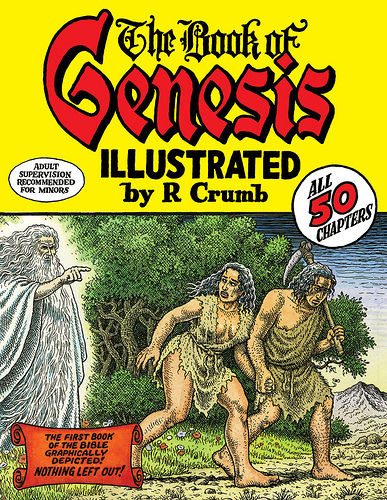Welcome to Comics Are My Religion, a look at theology through the lens of comic books.There are some basic ground rules about engaging in respectful dialogue about religion in this column. Be warned, if you haven’t read the comics discussed below, you might want to go read it and come back, as this column may contain spoilers!

This month, I’m going to do something I’ve never done before in this column. I’m going to review a book I haven’t completed. In this case, I’ll make an exception because I’ve read the Book of Genesis more than a few times, so I know how it’s going to end.
However, this Genesis is a little bit different.
Last year, renowned underground comics legend R. Crumb published The Book of Genesis Illustrated. Ironically, I’m not much of a fan of R. Crumb’s art nor illustrated books of the Bible. I remember sitting in the doctor’s office as a child and seeing an illustrated children’s Bible, and was struck by how unreal the characters were. They were nothing like the biblical heroes in my own head.
This book got some critical notoriety for a couple of reasons. First, no one thought Crumb would publish something like this. Second, taking the 50 chapters of Genesis and illustrating them is no small feat. And for the most part, the critics really liked this take on the first book of the Jewish Torah and Christian Old Testament.
 But one other thing that gained Crumb some press, at least in the advertising of this book, is supposedly it’s a word-for-word translation of Genesis. Crumb painstakingly letters every word of the book, and illustrates every scene with great precision. However, to say that this is not without interpretation would be a mistake.
But one other thing that gained Crumb some press, at least in the advertising of this book, is supposedly it’s a word-for-word translation of Genesis. Crumb painstakingly letters every word of the book, and illustrates every scene with great precision. However, to say that this is not without interpretation would be a mistake.
The cover of the book states “The first book of the Bible graphically depicted! Nothing left out!” This is true. Crumb includes all the sex, all the violence, all the nudity, and all the weirdness of Genesis. He doesn’t leave much to the imagination. You might not want your 5-year-old reading this version.
And I guess that’s my problem with “literal” graphic depictions of biblical stories, and Crumb’s is no exception. I am by no means a biblical literalist, so I like the written story much better, because it leaves so much to interpretation.
 This book is full of Crumb’s own interpretation. In order to fill in some blanks needed to depict the story visually, he makes some crucial decisions. For example, he envisions the serpent from the Fall of Adam & Eve story as having arms and legs and walking upright like a man before God curses him to slither on his belly. While the written text is ambiguous there, Crumb uses his imagination to fill in the gaps.
This book is full of Crumb’s own interpretation. In order to fill in some blanks needed to depict the story visually, he makes some crucial decisions. For example, he envisions the serpent from the Fall of Adam & Eve story as having arms and legs and walking upright like a man before God curses him to slither on his belly. While the written text is ambiguous there, Crumb uses his imagination to fill in the gaps.
There’s absolutely nothing wrong with using some creativity to help where the original text fails, but when the book is touted as being a word-for-word illustration, one has to wonder if that’s even possible.
I prefer creative interpretation, much like the book Marked by Steve Ross, instead of supposedly “realistic” takes on the Bible. I like that Crumb thought of the serpent like that, but it didn’t fit the rest of what he was trying to do. Interpretation always gets in the way of literalism, and ultimately, makes it difficult to do something as weighty as graphically depicting all 50 chapters of Genesis.
 That’s what I find interesting about biblical literalism. It’s impossible. Everyone brings their own worldview and experience when reading Scripture. So when people say that they think the Bible is literally true, I ask them questions like, “On what day was man created?” If the Bible is literally true, then one immediately has a problem, because there are two creation stories in Genesis chapters 1 & 2. Man is created differently in each one. It doesn’t mean that there isn’t truth to be gleaned from those stories, but they are certainly not literal. We bring our own idea of realism into every biblical story that we read.
That’s what I find interesting about biblical literalism. It’s impossible. Everyone brings their own worldview and experience when reading Scripture. So when people say that they think the Bible is literally true, I ask them questions like, “On what day was man created?” If the Bible is literally true, then one immediately has a problem, because there are two creation stories in Genesis chapters 1 & 2. Man is created differently in each one. It doesn’t mean that there isn’t truth to be gleaned from those stories, but they are certainly not literal. We bring our own idea of realism into every biblical story that we read.
And Crumb does the same. He does a pretty good job of it, too. But is it a word-for-word translation? Yes and no. Is it a hefty biblical tome to be appreciated as Crumb’s vision for the biblical text? Definitely. Crumb even admits that he uses his creativity in the forward to the book, and I appreciate that too. So this, just like those books in the doctor’s office when I was a kid, is just another version for us to chew on.
What are your thoughts on biblical interpretation as it regards this book? I’m sure there are varied opinions, and encourage you to share in the comments below!
Jeff Jackson
jeff@comicattack.net


Nice job Jeff. Sounds like an interesting read for sure.
Yeah, this sounds intriguing,and personally I’m a big fan of Crumb… As for a word for word translation, in the comics medium, surely some of those words are going to have to be translated into visuals, otherwise you’re just reprinting the book… And sure that’s going to lead some people dissapointed with the visualisation, just like every Hollywood movie adaptd from a popular novel does… If no-one ever ‘used creativity to help wher the original text fails’ there’d only be the one version of Christianity today. Not that I’m suggesting we should all convert to Crumbianism…
Pingback: Tweets that mention Comics Are My Religion: R. Crumb’s Genesis -- Topsy.com
Man, I want this book! Crumb is unparalleled for his linework, his attention to detail and his wide range of subjects tackled. This book was a total surprise for me and I hope to have it someday, even though I am an agnostic.
Yes, Ken, check this book out. Crumb’s art is fantastic. A must-have for the shelf.